The Tourbillon In The 2000s: Everything Everywhere All At Once
Tourbillon evolution, fast forward.
The tourbillon, as we’ve seen, was for the most part a device used quite rarely in watchmaking almost from its inception. Sure, Breguet’s invention had its fascination but its appeal as a part of the pursuit of precision at the bleeding edge, was largely confined to watchmakers, and not watch clients. It says something about the complication’s relative obscurity, and lack of appeal to consumers (most of whom wouldn’t have been able to tell you what a tourbillon was with a gun to their heads) that some of the most famous complicated watches of the 19th and 20th centuries did not have a tourbillon at all, up to and including Henry Graves Supercomplication, which was the world’s most complicated watch until the advent of the Patek Caliber 89 in 1989 (which, just to drive home the point, also did not have a tourbillon, and which was followed by the Star Caliber 2000 pocket watch, in 2000, which also did not have a tourbillon, and which was followed in 2001 by the Skymoon Tourbillon wristwatch, which did have a tourbillon).
Since the beginning of the 21st century, no other complication or mechanism has been the beneficiary of so much out-of-the-box thinking than the tourbillon, which is pretty amazing when you consider just how little out-of-the-box thinking that there was before then, at least when it comes to the technical side of tourbillons. However, as we saw in Tourbillon Chronicles Part III, starting in the late 1980s, the tourbillon became an essential part of the mechanical watch renaissance and by 2000, they’d become well-known enough, desirable enough, and popular enough that it was no longer enough to just be making a tourbillon – you had to do something nobody else was doing.
The Freak, And The Birth Of The Hyperwatch
In 2001, a watch appeared which had no precedent in the history of watchmaking – except that it did, although not quite in the way you might think. The Freak was (and still is) made by Ulysse Nardin, which had been part of the mechanical renaissance thanks to extremely exotic watches like the famous Trilogy Of Time astronomical complications, which had started to roll out in the 1980s. The company by the turn of the century, had further branched out into minute repeaters and jaquemarts automaton watches, but I think it’s safe to say no one saw the Freak coming.
The Freak was aptly named. In its original form, it consisted of a large, round, gold case with no crown. The centerpiece of the watch was the movement – the entire movement rotated once per hour in the case, doing duty as the minute hand. The original Freak was not a tourbillon in the usual sense of the word, but it did in fact have a rotating platform for the regulating components and thus, fits the wider definition of the tourbillon. The original concept was from Carole Forestier, currently at TAG Heuer and who was responsible for some of the 2000s most exotic complications at Cartier; Forestier won the Prix de la Fondation Abraham-Louis Breguet in 1998 for her design.
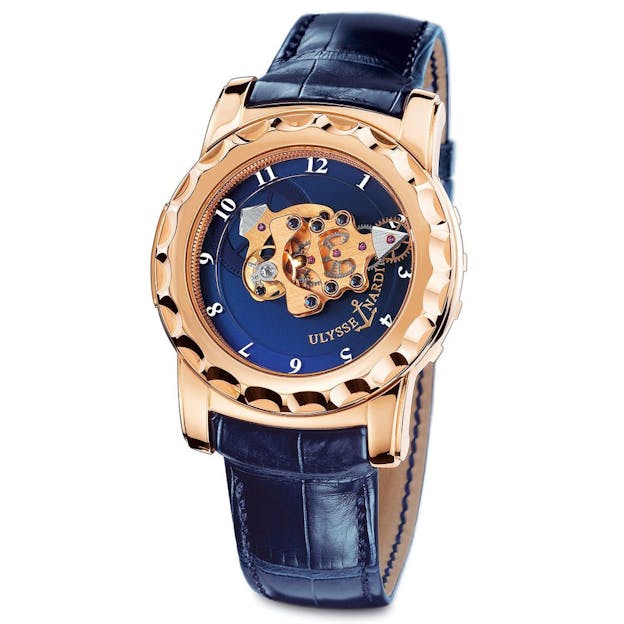
And the predecessor? Well, there are very few real firsts in watchmaking, but the Freak was preceded by over a century by the Waterbury Long-Wind, an American pocket watch with a nine-foot mainspring, and a movement which made one revolution in the case per day. It was not, to put it mildly, a groundbreaking achievement in watch design in the same way the Freak was – it was designed to be, above all, as cheap to make and sell as possible – but the germ of the idea was there.
The Freak was also the very first in a series of what enthusiasts have come to call hyperwatches – usually highly complicated, generally very exotic, and as a rule, extremely expensive examples of taking something that is theoretically possible, and turning it into a reality. As such, it was a shot in the arm to the entire industry – proof that sometimes, a crazy idea can lead to a dramatically different and indisputably successful reality.
Ultra-Thin Tourbillons
Making ultra-thin watches is such a specialized form of watchmaking that it is sometimes said that it’s a complication in its own right and this is especially true of ultra-thin tourbillons. A tourbillon necessarily – or you would think necessarily – introduces considerable additional height into a watch, thanks to the space taken up by the cage and, if the watch is not a tourbillon, the upper bridge. Notable modern ultra-thin tourbillons have been made by brands as varied as Breguet, Arnold & Son, Jaeger-LeCoultre, and Audemars Piguet, and for many years, the latter firm held the world’s record for thinnest tourbillon, thanks to the introduction of the reference 25643, in 1986 (as seen in Tourbillon Chronicles, Part III).
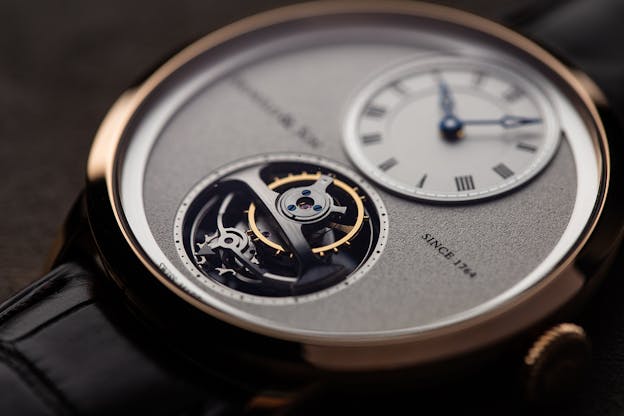
However, the current record for world’s thinnest tourbillon is held by Bulgari, which has been making record-breaking in ultra-thin watchmaking a fundamental part of its efforts as a modern watchmaker. In 2014, the company launched the hand-wound Bulgari Octo Finissimo Tourbillon, which had a case 5mm thick and which housed a movement just 1.95mm thick. The Audemars Piguet 25643, from 1986, was 4.8mm thick overall but did not have a conventional movement in a conventional case – the caseback was actually the movement plate.
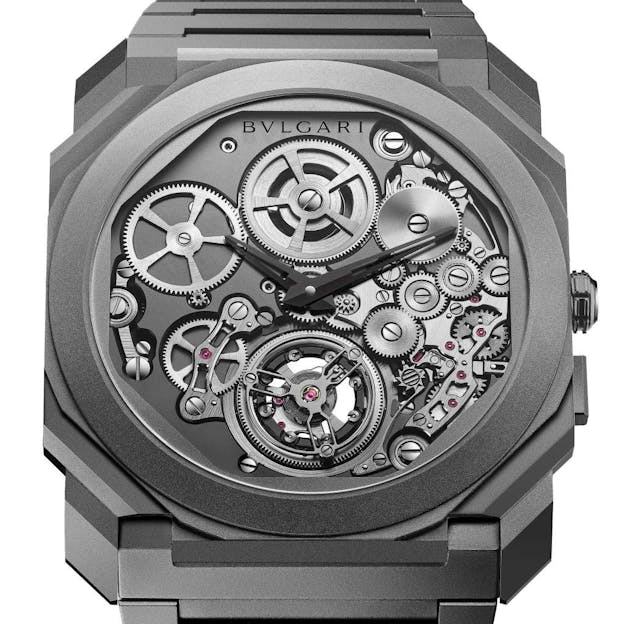
Bulgari would go on to beat their own record in 2018, with the Bulgari Octo Finissimo Tourbillon Automatic. This watch was then and still is now, the holder of three world’s records: it is the flattest tourbillon ever, the flattest automatic tourbillon ever, and the world’s thinnest self-winding watch of any kind. The watch overall is just 3.95mm thick and the movement, incredibly, is as thin as the movement in the hand-wound Octo Finissimo Tourbillon – just 1.95mm thick, thanks to a peripheral winding system.
Ultra-Long Power Reserve Tourbillons
The introduction of tourbillon watches with very long power reserves – above and beyond the usual 36 to 48 hours customary for most of the history of the wristwatch – also got off the ground in the 21st century and with rather startlingly early, and startlingly spectacular, results. One of the first in the game was Patek Philippe, who debuted their Ten Day Tourbillon (based on the same basic design as their reference 5100 Ten Day Power Reserve from 2000) in 2003. This was as you might expect from Patek, something of a purist’s take on a tourbillon, or at least, in retrospect it’s a purist’s take – the watch was devoid of any extraneous ornamentation unless you count the elaborately constructed step-sided Art Deco style case, and the tourbillon was not visible through the dial either.
One of the longest power reserve tourbillons came from a very unexpected source: Jacob & Co. We have long since gotten used to thinking of the company as a producer of baroquely complicated watches like the Astronomia Tourbillon, but back in 2006 the company was still associated with lavish gem-setting more than mechanical complexity. However, that was also the year that Jacob & Co. gave us the Quenttin tourbillon – a vertically oriented tourbillon in a 47mm x 56mm case, with seven mainspring barrels that took 200 turns to wind and which had a 31 day power reserve.
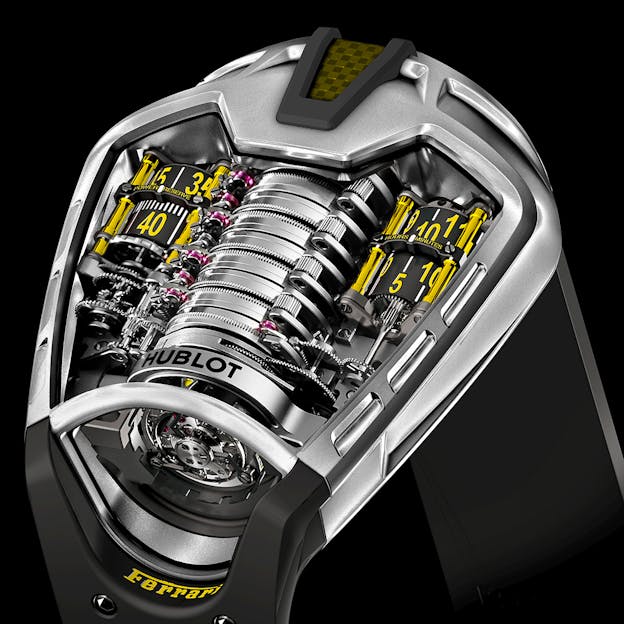
The all time record holder for longest power reserve in a tourbillon, though, came from another company that, while not necessarily first in enthusiast’s minds when it comes to complicated watchmaking.. Hublot’s take on the long power reserve tourbillon, the Hublot MP-05 LaFerrari, has eleven mainspring barrels, a 50 day power reserve, and an elongated case reminiscent of Darth Vader’s helmet. Aesthetically I can’t think of a tourbillon more diametrically opposed to the Augustan reserve of the Patek Ten Day Tourbillon than the LaFerrari, but whether or not it’s your cup of tea design-wise, it set a record for long power reserve tourbillons which remains unbroken today.
High-Speed Tourbillons
Tourbillons turn. The usual rate of rotation for tourbillons is one full rotation per minute (which is convenient because it lets you use one arm of the carriage for a seconds hand) but it is by no means written in stone that you have to go with one RPM (Omega’s observatory wristwatch tourbillon movements from the mid-20th century had a seven and a half minute period of rotation, for instance).
You can also go faster than one minute, if you are so inclined – there is a practical argument to be made for a faster rotating tourbillon, which is that the regulating system spends a much smaller amount of time in any given position. But, by and large, the primary reason for making a high-speed tourbillon is as a technical tour-de-force rather than as a definitive improvement to chronometry.
How fast can you go? Pretty damned fast. Franck Muller’s Thunderbolt Tourbillon holds the all-time record for high speed tourbillons, rotating at a truly blistering speed – once every five seconds, which requires some major changes to the standard tourbillon architecture. Normally a tourbillon has a fixed (non-rotating) fourth wheel, around which the cage rotates; the teeth of the fourth wheel gear to the escape wheel pinion, causing it to rotate as the cage turns. This in turn feeds power to the escapement and balance. The Thunderbolt Tourbillon has a fixed escape wheel, with inward facing teeth, which reduces the inertia of the components in the cage and contributes considerably to the ability of the tourbillon to rotate so quickly.

The notion of a high speed tourbillon has also found its way into multi-axis tourbillons as well, where the technical challenges are even greater. The current record holder for fastest rotation in a multi-axis tourbillon is held by a small company called Purnell, which makes a tourbillon called the Spherion. The Spherion Tourbillon consists of three tourbillon cages, nested inside each other, with each rotating at a different rate; from inner to outermost, the speeds are eight seconds, 16 seconds, and 30 seconds (30 second tourbillons are already a rarity). The Spherion Tourbillon comes in a number of different models but my personal favorite is the Escape II, which has two Spherions, for a total of six cages, which are linked by a differential.
Central Tourbillons
One very rare type of tourbillon – maybe the most rare of all – is the so-called central tourbillon, in which the tourbillon is placed at the center of the movement. This introduces some serious engineering problems to put it mildly (and it’s not as if the tourbillon doesn’t come with a history of engineering challenges even in its simplest form, or at least it did before the advent of CAD and CNC machines). Putting the tourbillon in the center of the movement is visually striking but it means that the entire rest of the movement has to be rearranged, including the barrel and going train, the keyless works for winding and setting, and the motion works for driving the hands – oh, and you can’t have conventional hands, either.
The central tourbillon is an extremely recent invention – Omega patented its central tourbillon, which was the first anyone had ever made, in 1995 and since then there have been only a small handful. This is partly owing to the fact that even as exotic tourbillons go, they’re a pain in the neck to make, and I think partly because the central tourbillon is still strongly identified with Omega, which still has a central tourbillon in its catalog.

The central tourbillon is thus often, but not always, produced by independent watchmakers when it is produced at all. Two prominent examples are Beat Haldimann, and Vianney Halter (for some time, Haldimann pretty much had the field to himself, other than Omega). Haldimann makes a couple of different central tourbillon watches. One of them is the H1 Central Flying Tourbillon, which has a quite beautiful Glashütte/Helwig-style flying tourbillon carriage (and an impressively large one at that). The second is the H2 Flying Resonance Tourbillon. This is a flying tourbillon with two balances – the cage has been reduced to a small platform supporting the double balance system, as well as the escape wheels and lever escapements. The most interesting feature of the watch, however, is the resonance system – this consists of a thin bar which mechanically couples the outer terminal curves of each of the balance springs.
Vianney Halter’s central tourbillon is the Deep Space Resonance Tourbillon. This is a watch in which several subtypes of tourbillons overlap – it’s a central, triple-axis tourbillon with a double balance, with the two balances mechanically linked, and coupled to each other, by virtue of their being situated on the same bridge. In terms of sheer complexity in a tourbillon system, this is right up there – although it does have in common with other central tourbillons, that the raison d’être for its existence is to provide a unique intellectual, emotional, tactile, and visual experience.

The only other central tourbillon of which I’m aware, which was not made by a small independent company, is from, of all brands, Bulgari, who launched the Octo Roma Central Tourbillon Papillon in 2021. This is a central tourbillon watch in a slightly unusual format – it’s a jumping hour watch with a window for the hours at 12:00, and orbiting dual minute hands, which change the direction in which they are pointing, depending on which one is currently active.
The Multi-Axis Tourbillon
We come last to what comes first in the world of modern tourbillon design: the multi-axis tourbillon. The multi-axis tourbillon is a well-established feature of modern watchmaking at this point, but ’twas not always thus. We have to jump back a little bit in time, to before the advent of the Freak and the birth of the hyperwatch, but the multi-axis tourbillon was actually invented by the English horologist, Anthony Randall, in 1977 and a clock was constructed to his design by Richard Good (who was a brilliant designer, engineer, and horologist in his own right – one of his accomplishments was for a fuse for the British version of the Polaris sub-launched ICBM, of all things). The clock was part of the now defunct Time Museum in Illinois and was auctioned by Antiquorum in 2005 (I haven’t been able to find any subsequent record of its resale). Richard Good also constructed the first triple axis tourbillon, in a clock, in the 1980s.
In watches, the first to put a triple axis tourbillon into a wristwatch was Thomas Prescher, who presented a single, double, and triple axis tourbillon all together at Baselworld in 2004 (a memorable and undeservedly forgotten debut). Since then multi-axis tourbillons have become, if not ubiquitous or even common, at least a regular part of the horological landscape in recent years.
Attribution: Charles Restalic, CC BY-SA 3.0, via Wikimedia Commons
Probably no brand’s more associated with multi-axis tourbillons than Greubel Forsey, which launched its first watch in 2004-2005. This was the Double Tourbillon 30º, which was and is one of the most visually interesting and beautifully finished watches of the last fifty years. The Double Tourbillon 30º has two tourbillon cages, with the inner, sixty-second tourbillon inclined at 30º to the four-minute outer tourbillon. At least as remarkable as the technical features of the watch, is the amount of effort lavished on the finishing. The term “hand-finished” is thrown around somewhat loosely – okay, very loosely – these days but the Double Tourbillon 30º is at least as unusual for the degree to which it is truly hand-finished in every component, as it is for its technical features. Since then Greubel Forsey has gone on to produce a number of other variations on the tourbillon, including a quadruple tourbillon, and high speed tourbillons as well, including the Tourbillon 24 Secondes, which has a 24 second tourbillon and a balance inclined at 25º.
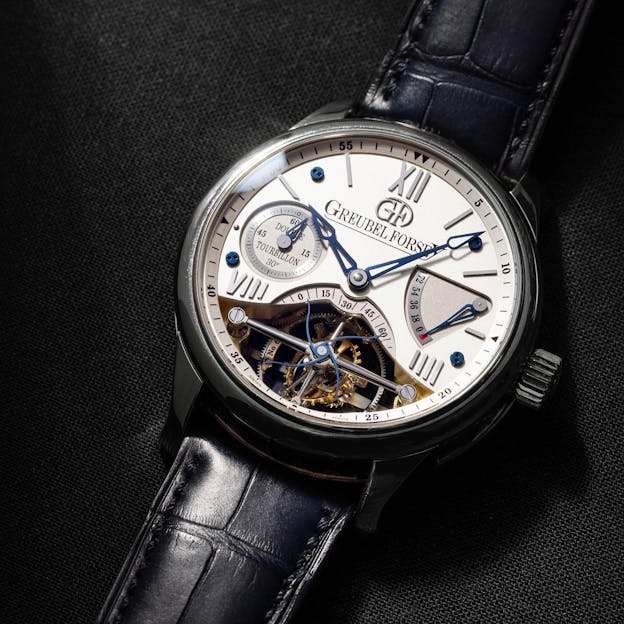
Jaeger-LeCoultre has also produced a number of multi-axis tourbillons over the years – including the five Hybris Mechanica watches. Each one of the five has its own unique features – a personal favorite of mine has always been the Reverso Hybris Mechanica Caliber 179, which in addition to being very successful from an overall design standpoint, has a semi-spherical balance spring.
Modern Tourbillons And The Pursuit Of Precision
Now, there is in fact a practical reason for a multi-axis tourbillon. The tourbillon was originally invented, by Breguet, for use in a pocket watch (there being no other kind of watch in 1801, when Breguet was granted his patent). In a pocket watch, as George Daniels explains it in Watchmaking, what you get is a single average rate for all the vertical positions. It is then merely necessary that you adjust the watch so that the rate of the flat positions (dial up and down) matches the single rate for the vertical positions, and you should in theory have a perfect timekeeper.
This reasoning applies to some degree to wristwatches as well but less so since a wristwatch, over the course of a day, will adopt a number of different positions other than flat or vertical – during a walk or while standing, for instance, the watch will be crown up; if you’re working at a computer keyboard, the watch will be dial up but also inclined slightly to the left. The idea behind a multi-axis tourbillon is that you can in theory get a single average rate for all positions (this is an oversimplification but that’s the general idea) and so you ought to be able to get improved precision in a wristwatch as well if you use a multi-axis tourbillon.

The reasoning is sound but as Stephen Forsey said to me many years ago (and I’ve never forgotten his comment) when creating a mechanism of this complexity, it’s always hard to make sure you gain more than you lose. However, during the relatively short period of time that chronometric competitions were taking place in the 2000s – at the now defunct Concours Internationale de Chronométrie, which was an initiative from the Musée d’Horlogerie du Locle – it turned out that at least under controlled circumstances, tourbillons could indeed produce extremely impressive results in precision. In 2009, the first year of the competition, the three top performers were all tourbillons: The Jaeger-LeCoultre Master Tourbillon (which is in fact a standard, not a mult-axis, tourbillon), the multi-axis Jaeger-LeCoultre Gyrotourbillon, and Chopard’s 16/1906 Tourbillon, took first, second, and third place respectively.
The Tourbillon: Modern Variations On A Theme
It says something about the sheer diversity of tourbillon design and engineering over the last twenty or so years, that the watches discussed above are barely a representative list of the basic varieties, let alone representative of all the major models and accomplishments. There are ultra-light tourbillons, mystery tourbillons (a staple for some years from Cartier) tourbillons with unusual escapements, and more. And you could write an entire article on tourbillon variants which exist as foundations for unusual visual presentations, like the Jacob & Co. Astronomia watches.

It is difficult, after 23 years of increasingly varied examples of upgrades, updates, and alterations to Breguet’s original idea (if in fact it was Breguet’s idea, a subject we looked into in Part II of The Tourbillon Chronicles). Without question, we have today a far greater range of tourbillons than Breguet could have possibly imagined, and he had a mighty active imagination. The tourbillon has also become de rigueur in any multi-complication watch, at leas much more so than in the pre-Quartz Crisis days, when even highly complex pocket watches did not have tourbillon regulators.
We will undoubtedly continue to see tourbillons in all the major categories we’ve looked at here, although probably not with the same florid variety that characterized the first fifteen years of the new century. Perhaps the tourbillon, like other kinds of watches, will experience a re-interpretation in a more classic idiom (at least for now, manufacturers seem unwilling to make a tourbillon without also making a hole in the dial). But at the same time, never underestimate the ingenuity of watchmakers – the only thing we can be sure of when it comes to the tourbillon, is that someone will think of doing something the rest of us would never have thought of on our own.


